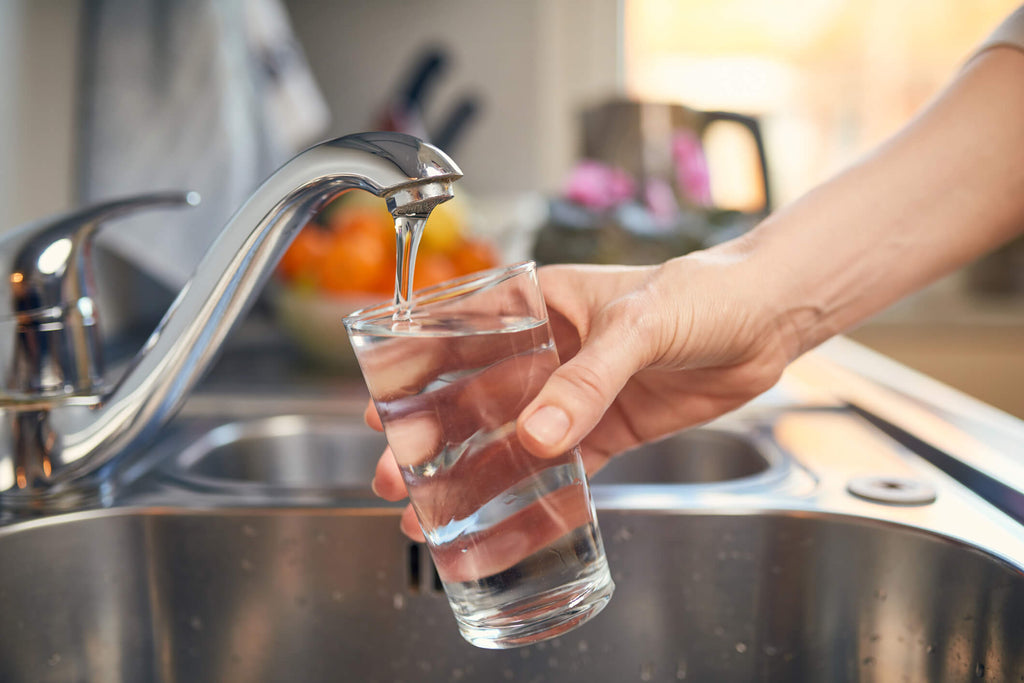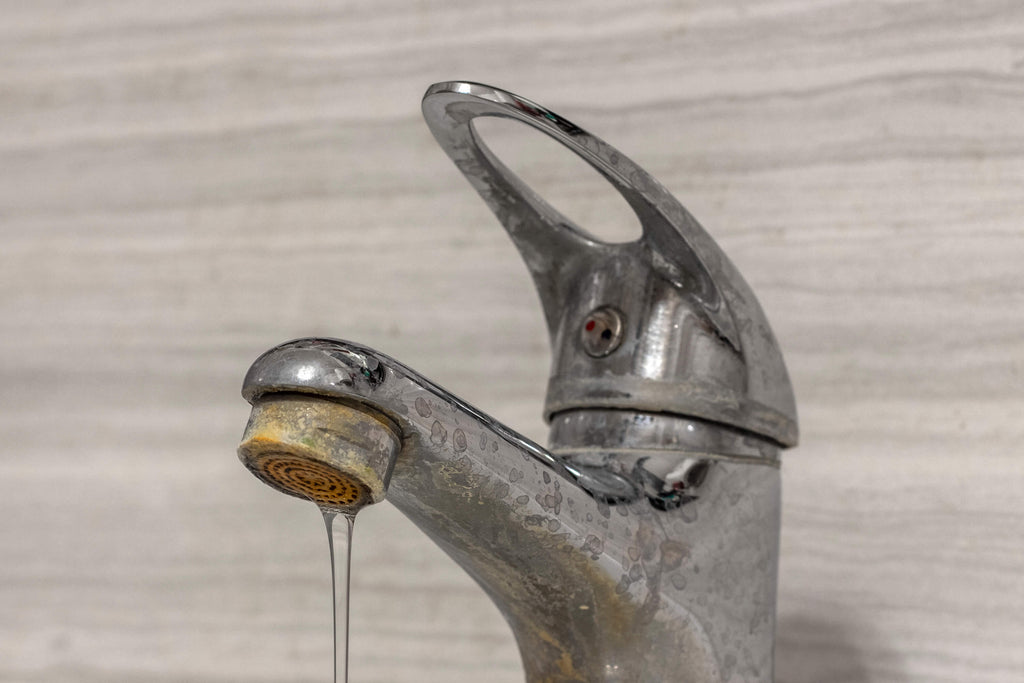Clean tap water is often something Americans take for granted. However, when water lines become contaminated, we are quickly reminded of the benefits of regulated water. The water treatment process has evolved over time, and water has become safer as technology and regulations have evolved. Despite the advance of technology in water treatment, there are many valid questions consumers have about their tap water. Below you can find information about what chemicals are used in the water treatment process, the steps of city water treatment, and if tap water is safe to drink.
What chemicals are used in city water treatment?
The most common chemical additives to public water are chlorine and fluoride. Other chemicals, such as aluminum sulfate and organic polymers, are added in the early stages of the treatment process. Other municipal water treatment plants replace chorine with chloramine, a less volatile and longer-lasting disinfectant. While the sound of chemicals in your tap water may seem frightening, the benefits these chemicals have on water make them essential in water treatment. For example, without chlorine in your tap water, bacteria, viruses, and parasites can linger in pipes and eventually contaminate your body. Fluoride, on the other hand, is added to decrease the risk of tooth decay. The addition of fluoride has been and remains controversial, as some studies have linked it to health defects such as lower IQ, neurological problems, and high blood pressure. However, according to the CDC, these health defects are not linked to fluoride in water.
Learn more: How to Remove Fluoride from Water
Chemicals like aluminum sulfate and polymers are used in coagulation and flocculation. Unlike chlorine and fluoride, these chemicals react in the water with debris and therefore do not reach the final product. While aluminum sulfate is fairly non-toxic, the EPA requires that its levels in tap water are no more than 0.2 parts per million.
What does city water treatment remove from water?
The entire process of city water treatment reduces the levels of many contaminants, including the following:
- Debris
- Sediment
- Dirt
- Dust
- Chemicals
- Parasites
- Bacteria
- Viruses
Where do cities get their water from?
While cities get their water from varying locations, there are three types of water supplies used by water treatment plants.
- Surface water
- Groundwater
- Recycled water
Surface water
Surface water is exactly what it sounds like, water that collects on the surface of the ground. Because they are on the earth’s surface, they are subject to contamination via pollution. Surface water requires more treatment than ground water because it contains more sediment, germs, chemicals, and toxins than ground water. Examples of surface water include streams, rivers, lakes, wetlands, reservoirs, and creeks.
Groundwater
Groundwater is found beneath the soil surface in pore spaces of bedrock, sand, and gravel. It is the most common source of drinking water in the United States. Of the three types of water sources, groundwater is typically the cleanest, but it often contains elevated levels of water hardness minerals, like magnesium and calcium, picked up through seepage. Examples of groundwater include springs, wells, and infiltration galleries.
Learn more: What is Groundwater Contamination and How Do You Treat It?
Recycled water
Recycled water is water that is reused from some other application. Examples of recycled water include sewage, stormwater runoff, and industrial waste. This type of water requires the most treatment because there are more contaminants to remove.

What is the city water treatment process?
Just like how water sources from municipality to municipality vary greatly, the water treatment process can differ substantially from city to city. While specific water treatment techniques are not identical among cities, all municipalities follow a general water treatment process. The following are steps commonly used in the water treatment process.
Chemical coagulation
Chemical coagulation is the addition of chemicals to a water supply to collect debris and dissolved particles. These particles are too small to settle to the bottom of the water supply, so a chemical coagulant must be used to clump them. These clumps weigh enough to settle to the bottom of the water in a layer called floc.
The most common chemical used in chemical coagulation is aluminum sulfate. Other chemicals, such as sodium aluminate and ferric sulfate, can also be used for coagulation. These coagulants are evenly distributed in the water supply with high-speed mixers. The chemicals contain a positive charge that neutralizes the negative charge of dissolved and suspended particles. This reaction causes the particles to bind together and settle to the bottom of the water.
Flocculation
Flocculation is an extension of coagulation. Once coagulation is completed, the mixers must slow down to prevent the floc from separating again. In flocculation, a polymer is added to bind smaller clumps of floc into larger chunks. This ensures that the floc will not break apart when the water is agitated and makes the layer easier to remove. Once this flocculation is completed, the floc layer can be removed via filtration.
Filtration
Once the layer of floc has settled, the water must be filtered to remove contaminants such as suspended particles that were not previously removed, bacteria, viruses, and unwanted chemicals. These filters can contain materials such as sand, gravel, and charcoal. Ultrafiltration is also used by some municipalities to remove contaminants.
In some cases, a water treatment plant may be using recycled water from sewage lines, stormwater runoff, or industrial waste. Reverse osmosis filters are commonly used to treat this water or saltwater supplies. Reverse osmosis filters are effective against wastewater and saltwater because they remove a vast majority of contaminants from water. These can be advantageous to islands, or water-scarce communities where the only available water source is brackish or otherwise contaminated.
Learn more: What is Brackish Water and How Do You Treat It?
Disinfection
Once the water is filtered, chemicals must be added to remove any remaining viruses, parasites, and bacteria. Chlorine serves as the disinfectant and fluoride is also added to prevent tooth decay. When water leaves the plants and travels to a building for use, small amounts of chlorine remain to remove any bacteria that resides in the pipes.

Is tap water safe to drink?
Yes, tap water is safe to drink, but adding a filtration system for drinking and cooking water will decrease the chances of negative health effects down the road. The EPA regulates how much of each contaminant is allowed in city-treated water, and treatment plants are held accountable should water not hold up to these standards. Keep in mind that the EPA simply regulates amounts that are unlikely to cause long-term health effects. When it comes to contaminants in drinking water, there are ideal levels of contamination and there are realistic levels that a water treatment plant can achieve. For example, the ideal lead contamination in water is zero, but eliminating all lead from water would cause treatment costs to rise too high. As a result, the EPA mandates that lead levels must not exceed 15 parts per billion in treated water. Side effects of even miniscule lead exposure include reproductive harm, decreased kidney function, increased blood pressure, behavioral problems in children, and decreased intelligence. While these effects are unlikely with lead exposure, they are possible when the lead level in water is not zero.
A simple refrigerator filter uses an activated carbon core that removes chlorine, but contaminants such as lead, arsenic, nitrate, and fluoride cannot be removed with many refrigerator filters. Some filters, such as this filter by Neo-Pure, are rated for more contaminants than just chlorine. However, if you wish to make tap water as pure as possible for drinking, a reverse osmosis system is your best bet. Chloramines are more complicated to remove, and require lengthy contact with Vitamin C filters, or other specialty filtration methods. If you want other filtration options, you can read about how to filter specific contaminants from water on the “Contaminants” section on our blog.
Learn more: What is a Reverse Osmosis System and How Does it Work?
A newer threat to drinking water is known as PFAS (per and polyfluoroalkyl substances). These chemicals earned the nickname “forever chemicals” because they are stable in water and remain in the environment and the human body for extended periods. According to the Environmental Working Group, a majority of Americans’ tap water contains at least 1 part per trillion of PFAS. While this may seem like an insignificant amount, PFAS stay in your body for years. If you were not to intake any additional PFAS in the next four years, the PFAS levels in your body would decrease by about 50 percent. Because PFAS remain in the body for so long, the 1 part per trillion can add up quickly. Fortunately, a home water filtration system can reduce PFAS levels in your drinking water.
Why does my tap water taste bad?
The three most common causes of foul-tasting tap water are water hardness, chlorine, and chloramine. Some states, such as Utah, New Mexico, Wisconsin, Indiana, Florida, and the western half of Texas, have water that is loaded with calcium and magnesium. While the levels of these minerals in water are not detrimental to health, they do cause water to have a bitter flavor. This bitter taste could also be the result of corroded copper plumbing in your home. A water softener combined with a reverse osmosis system will help your hard water taste pure and refreshing. Chlorine, on the other hand, is added during water treatment to eliminate bacteria, viruses, and parasites. While this helps keep water safe as it travels to your home, it compromises your tap water’s taste. A refrigerator filter uses an activated carbon media to reduce chlorine levels in water, giving it a crisper taste.
Learn more: How to Improve Bad Tasting Tap Water

Does city water treatment remove water hardness?
No, city water treatment does not remove water hardness. City water regulations are designed to make water drinkable, and hard water is not dangerous for humans to consume. However, hard water can wreak havoc on plumbing and appliances. Without being removed, minerals that cause hard water create scale buildup in pipes that leads to low water pressure and constant appliance malfunctions. If your region has hard water, you will want to invest in a water softener to protect your appliances and plumbing.
Learn more: What Is a Water Softener and How Does It Work?
If you have any further questions, please do not hesitate to contact us.
